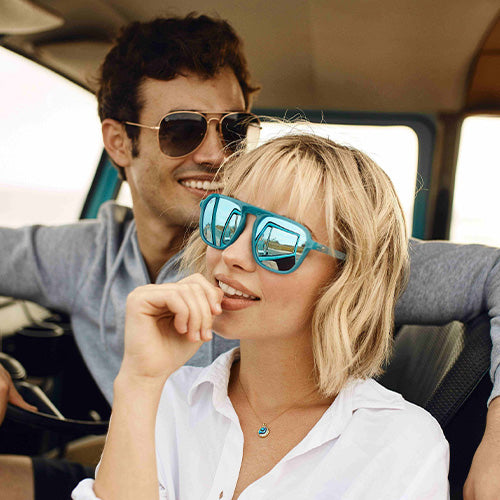Finding the right fit for glasses of all kinds can come down to one number: pupillary distance. Let’s look at pupillary distance meaning, how to measure yours, and how pupillary distance may help you select the perfect pair of shades.
WHAT IS PUPILLARY DISTANCE?
Also called interpupillary distance, your pupillary distance (PD) refers to the distance between the centers of your pupils. It’s a common metric used to determine the positioning of the optical centers of your lenses. Eyecare professionals use PD to help make sure lenses align with the eyes correctly. With prescription eyewear, PD helps to ensure optimal visual clarity by aligning lenses with the visual axes of the eyes. This correct alignment allows light to pass through the appropriate part of the lenses, and thus the glasses wearer sees more clearly.
While an optometrist or an optician typically measures PD during an eye exam, you can measure it yourself at home.

Photo Credit: Marina Vitale/Unsplash
MEASURING YOUR PUPILLARY DISTANCE
You will need a millimeter rule. And it’s best if the ruler has clear markings, as you’ll be taking precise measurements. Don’t have a millimeter ruler? You can google “printable millimeter ruler” and print one out. Just make sure your printer settings don’t scale the image.
Stand in front of a mirror, staying about eight inches from its surface. Bathroom mirrors work well, as you should be in a well-lit area that makes it easier to read the ruler. Position your face directly in front of the mirror, with your eyes relaxed and looking straight ahead. Don’t move your head; even slight shifts in head position could lead to inaccurate measurements.
Place the ruler horizontally across your forehead, just above your eyebrows. Make sure that the ruler is straight and level with the floor. Make a mental note of the zero mark on the ruler.
Next, focus on one eye only and align the zero mark of the ruler with the center of that eye’s pupil. Close that eye, allowing the other to focus. Note the measurement where the center of your pupil aligns with the ruler. Repeat the process until you have a consistent number. That’s your PD.
TAKE YOUR PD MEASUREMENT WITH A FRIEND
Just as you would measure your own PD with a mirror, your friend should be about eight inches from your face. While measuring alone with a mirror, you look directly at your reflection. Here, look past your friend while they are taking your PD measurement. And your friend should try to stay out of your field of vision as they hold up a ruler to measure the distance between the centers of your two pupils.
GET A PUPILLARY DISTANCE RULER
While a regular millimeter ruler can do the job, you can get a ruler designed to measure pupillary distance. You can buy these PD measuring tools online for $5 to $10. Differing from regular rulers, PD rulers have a notch to set the ruler on the bridge of a person’s nose.

Photo Credit: Ennie Horvath/Pexels
USE A PD MEASUREMENT APP
Using a ruler is simple enough. But more tech-savvy folks might choose to use one of the many apps that measure PD. Available for both Android and Apple devices, PD apps use facial recognition algorithms to measure the distance between pupils.
Which app should you choose? GlassesOn is a top-rated PD app. Touted as “the only medical-grade app for PD,” GlassesOn measures PD in under a minute. The GlassifyMe app is another top option. It’s got a user-friendly interface and simple step-by-step instructions.
No matter which method you use, it is important to understand that measuring your pupillary distance at home may not be as accurate as a measurement taken by a professional. Optometrists and opticians use more precise methods, such as pupillometers, to ensure accurate measurements. But if your goal is to get pretty close, a home measurement will do.
AVERAGE PUPILLARY DISTANCE AND SUNGLASSES SIZE
There isn’t always a direct correlation between pupillary distance and face size. But it is common for people with smaller PDs to have smaller faces. Similarly, pupillary distance can be a useful tool in fitting sunglasses to medium-sized and larger faces. And so your pupillary distance may help you select the right pair of shades.
Where does your PD measurement fall? Most adults have a pupillary distance range between 50 and 75 millimeters. 63 millimeters is the average, with little difference between men and women.
SUNGLASSES FOR SMALLER FACES
Perfect for people with smaller faces, Paso Robles exude the unique style of the California town for which they’re named. Set back from the Pacific Coast, Paso Robles has laid-back landscapes where rolling hills are rich with some of California’s top vineyards. The contoured lenses and rounded corners of these down-to-earth sunglasses capture both the land’s Mediterranean climate and its easygoing California vibe.
At once vintage and contemporary, Seventy Nines let you show your fashionable side with square-shaped retro frames. And a low-profile silhouette that keeps the fashion statement ever so subtle. Casually cool and versatile, these unisex shades feel at home just about anywhere. And if that anywhere happens to be bouncing around on a far-flung adventure, you’re in luck; like all Knockarounds, Seventy Nines have FDA-approved impact-resistant lenses!
Sophisticated. Timeless. And, well, classic. These are a few words that accurately describe Classics, sunglasses that look good on just about everyone. Though they are especially good fits for people with small to medium-sized faces. What makes them so classic? History. These shades are modeled after sunglasses popularized by open-road pioneers nearly a century ago. Given how contemporary these sunglasses seem, that may be hard to believe—but it’s true!
SUNGLASSES FOR SMALL TO MEDIUM FACES
Smart, fun, and always ready for exploration, Mary Janes ooze retro charm with rounded lenses and slender wire frames. With Knockaround’s standard UV400 protection, they’re ready to protect your eyes at the beach but feel just as right when slipped on for more upscale, cosmopolitan outings.
Durable and lightweight, Premiums Sport are built to go with active lifestyles. An embedded rubberized nose pad keeps your sunglasses secure while running, biking, hiking, and doing just about anything where no-slip shades are a must.
Few sunglasses offer as unique a take on aviation style as well as Mount Evans. Breaking free from the traditional teardrop shape that’s defined aviator glasses for nearly a century, Mount Evans offer a square-shaped design that’s perfect for people with small to medium-sized faces.
SUNGLASSES FOR MEDIUM TO LARGE FACES
Classic aviation design is on full display with Mile Highs, sunglasses that pay homage to the shades worn by pilots during World War II. This traditional teardrop shape lends itself well to people with medium- to large-sized faces. Polarized to cut down on glare from the sun, unisex Mile Highs have slim wire frames and come in a wide range of colors.
You’ll love the comfortable fit of Fort Knocks; injection-molded frames and hidden spring hinges combine to provide wonderful wearability. The form-fitting shape presents a timeless silhouette that’s at home with just about any occasion. So why do we call them Fort Knox? They’re as tough as the famed depository that holds U.S. gold reserves!
Rounded rectangular frames usually look great on people with medium- to large-sized faces. And all the better if those shades embody Pacific beach style! Just like the seaside spot they’re named after, Pacific Palisades love a summer day with toes in the sand and good vibes all around. Rounded rectangular frames with a retro brow bar present a laid-back attitude that’s always down for fun under the California sun.
SUNGLASSES FOR LARGER FACES
Campeones, one of the most action-forward shades you can find, are ready to get active. These wraparound shades are great for people with large faces. But just about everyone can take advantage of oleophobic and hydrophobic lens coatings that repel water, oil, and sweat. And don’t worry about (pun intended) knocking them around. Campeones have our proprietary impact-resistant Knockterra™ performance lens tech.
You don’t have to live in life’s fast lane to look as if you do. Always up for a summer road trip, Fast Lanes have streamlined rectangular lenses that complement medium to large faces. Looking for a playful pop of color? Maybe you’ll choose to rock the warm sunset colors of the Desert Fast Lanes, or go with a cool, deep blue with a pair of Harbor Lights Fast Lanes. We’ve got a massive range of colorways to suit your style!
If you’ve got a large face, you might consider sunglasses with extra-wide lens coverage. And so a pair of Torrey Pines may be perfect. Broad rectangular lenses offer full coverage at the beach, out on the water, or just about anywhere you want protection from the sun’s rays. With Knockaround’s signature UV400 protection. And with a unique design that’s inspired by the unspoiled beauty of the stretch of California coast for which they’re named.
Whatever your interpupillary distance, face size, or sense of style, Knockaround has the right pair of shades for you. Check out some of our best-selling sunglasses today!
Written by William McCleary for Knockaround.















Best Road Trip Accessories
What to Pack for a Beach Vacation